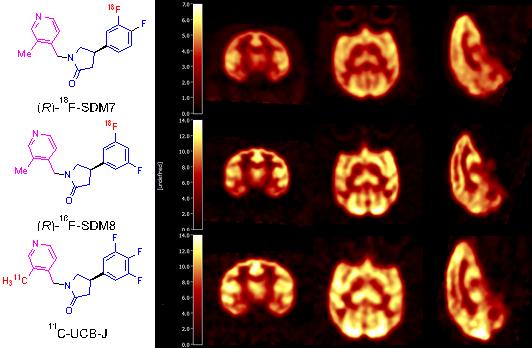Nuclear tracers help assess new drugs for neurodegenerative diseases
Posted: 21 January 2019 | Dr Zara Kassam (Drug Target Review) | No comments yet
New nuclear medicine tracers could help medical researchers find a cure for Alzheimer’s and other neurodegenerative diseases.


New nuclear medicine tracers could help medical researchers find a cure for Alzheimer’s and other neurodegenerative diseases.
The development of therapies for neurodegenerative diseases has been hampered by the lack of a reliable and sensitive method to detect the disease early and to effectively monitor the performance of experimental drugs. Synapse loss is one of the earliest and most robust biomarkers for Alzheimer’s disease, and quantification of synaptic density in the central nervous system could be used to detect a variety of neurodegenerative diseases at their earliest stage, track disease progression and monitor the effect of therapy.


This figure shows the chemical structures and brain PET images of the novel 18F-labeled SV2A PET tracers, 18F-SDM-7, 18F-SDM-8, and the lead tracer 11C-UCB-J in nonhuman primates. Z Cai and S Li et al., Yale University, New Haven, Conn.
Positron emission tomography (PET) imaging can obtain crucial information about synaptic density that cannot be acquired through other approaches. Previous research identified a radiotracer (11C-UCB-J) for the synaptic vesicle protein 2 (SV2A) that was successfully used to image synaptic density in vivo; however, its characteristics were not conducive to clinical use.
“We set out to develop 18F-labeled SV2A tracers with imaging characteristics comparable to those of 11C-UCB-J,” said Dr Zhengxin Cai, of the Department of Radiology and Biomedical Imaging at Yale University. Dr Cai, together with Dr Songye Li, and colleagues from the Yale PET Center, were able to successfully synthesize and evaluate a number of novel SV2A tracers with attractive imaging properties: high brain uptake, fast tissue kinetics, and high specific binding signals in the brain. “With a longer half-life,” Dr Cai said, “our new tracers are suitable for multicenter clinical trials, routine clinical use and potential commercialization.”
As new generations of drugs are undergoing clinical trials for neurodegenerative diseases, the new radiotracers will be able to facilitate the development of therapies, providing a novel tool for identifying which patients may benefit from a particular treatment and then for assessing its therapeutic effect.
“The successful development of our new SV2A PET tracers for synaptic density imaging and their use in the study of a variety of neurologic and psychiatric disorders will play a crucial role in CNS drug discovery and development,” said Yiyun Henry Huang, professor of Radiology and Biomedical Imaging, Director of Chemistry at the Yale PET Center, and senior author of the research presented at the meeting.
The research was presented the SNMMI 2018 Annual Meeting,
Related topics
Cell Regeneration, Imaging, In Vivo, Label-free, Neurons, Neuroprotection, Neurosciences, Therapeutics
Related conditions
Alzheimer's
Related organisations
Yale University
Related people
Dr Songye Li, Dr Zhengxin Cai



